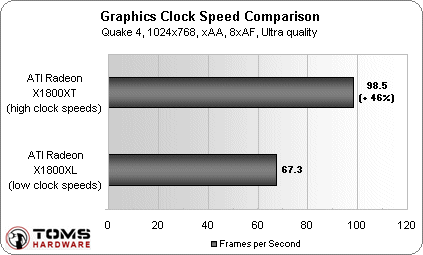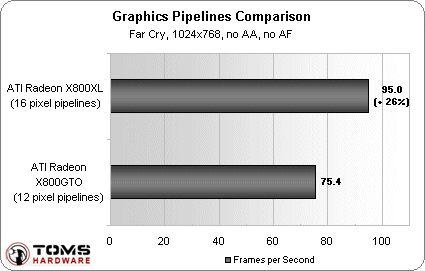Graphics Beginners' Guide, Part 3: Graphics Performance
Theory Becomes Reality: Performance Analysis
Theory means nothing if it doesn't translate into performance and a great visual experience. The following benchmark examples will illustrate some of the practical considerations discussed above.
Clock Speed Comparison
Clock speeds have a direct and measurable impact on graphics card performance. In this example we analyze the ATI Radeon models X1800XL and X1800XT. Both of these cards use identical architectures and have an identical 256-bit memory interface; the only difference is their clock speeds.
The Radeon X1800 XL has a graphics processor core clock speed of 500 MHz and a memory clock speed of 500 MHz (1000 MHz effective). The X1800 XT has a core clock speed of 625 MHz and a memory clock speed of 750 MHz (1500 MHz effective)
How do these differing clock speeds affect performance?
As you can see, in this case the higher clock speeds have a very profound effect on the actual performance. Keep clock speeds in mind when considering relative performance.
Number Of Shader Units
Graphics processor architecture is also very important to keep in mind, in addition to clock speeds. In this example we will examine the ATI Radeon X800 XL and X800 GTO models. Both of these cards have identical clock speeds and 256-bit memory interfaces. However, the Radeon X800 XL has a 16 pixel shader units, while the X800 GTO has the same processor, which is crippled to only use 12. Let's see what difference this makes in performance, all other factors being equal:
This just goes to show that clock speeds are not everything. Architecture is also very important when comparing the performance of two graphics cards.
Get Tom's Hardware's best news and in-depth reviews, straight to your inbox.
Current page: Theory Becomes Reality: Performance Analysis
Prev Page Graphics Performance Dissected Next Page Memory ComparisonDon Woligroski was a former senior hardware editor for Tom's Hardware. He has covered a wide range of PC hardware topics, including CPUs, GPUs, system building, and emerging technologies.

